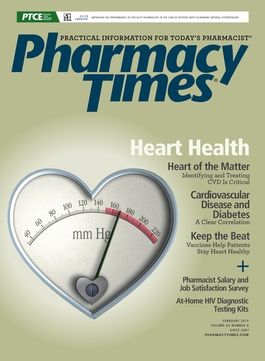Publication
Article
Pharmacy Times
Vaccinations Promote Heart Health
Author(s):
Immunizations lower the risk of cardiovascular complications, preventing serious illnesses and saving lives.
One of the top causes of morbidity and mortality globally is cardiovascular disease. (CVD), as this condition can make it more difficult for patients to fight off infections.1,2 Further, vaccine-preventable diseases can increase the risk of cardiovascular complications. Immunization is especially important in this patient population. Vaccines are the best way to prevent serious illness, hospitalization, and even death. Pharmacists can play an important role in administering vaccines and educating patients with CVD.
RECOMMENDED VACCINES AND STUDIES
Patients should be up-to-date on all vaccines recommended by the CDC. These 4 are especially important in patients with heart disease: influenza; pneumococcal; tetanus, diphtheria, and acellular pertussis (Tdap); and zoster.2 Advise those with heart disease to receive an annual flu vaccine. Study results show that influenza can trigger adverse cardiovascular events, such as acute myocardial infarction (MI).3 The PARADIGM-HF study of more than 4000 patients is examining whether in-hospital influenza vaccination can serve as secondary prevention after MI; this is the largest randomized trial to evaluate this outcome.3 Trial results show that influenza vaccination was associated with reduced mortality. However, this conclusion was considered an association rather than a causative effect, because it was observed in a cohort of patients.4
Results from a meta-analysis of 5 observational studies presented at a recent American College of Cardiology meeting showed that influenza vaccination was associated with reduced risk of death in patients with heart failure.5 The CDC does not recommend 1 flu vaccine over another for patients with heart disease, but evidence suggests that Fluzone High-Dose, approved for individuals 65 and older, provides better protection because patients with CVD may have a decreased immune response to the standard-dose vaccine.1 This flu season, the live nasal spray vaccine (FluMist Quadrivalent) is an option, but there is a precaution against using it in patients with underlying medical conditions, such as heart disease.6 Therefore, the inactivated influenza vaccine is the best option for those with CVD.6
The CDC recommends that individuals aged 19 to 64 years with chronic heart disease, excluding hypertension, receive 1 dose of the 23-valent pneumococcal polysaccharide vaccine (PPSV23).7 At age 65 or older, patients should receive 1 dose of the 13-valent pneumococcal conjugate vaccine (PCV13) if they did not previously receive it. Another dose of PPSV23 should be administered at least 1 year after PCV13 and at least 5 years after the first dose of PPSV23.7There are limited studies evaluating the efficacy of the pneumococcal vaccine in reducing cardiovascular events. However, the vaccine was associated with a lower risk of acute coronary syndrome in a meta-analysis of 8 studies in patients 65 and older.8
Stronger randomized-controlled trials are needed to demonstrate a causative effect. Pharmacists should continue to recommend and administer the pneumococcal vaccines to prevent MI.
The Tdap vaccine should be administered to adults who pre- viously did not receive a dose as an adult or child—this routine vaccine is recommended at age 11 to 12 years—followed by a tetanus and diphtheria toxoids booster every 10 years.7 Pregnant women should also receive 1 Tdap dose for each pregnancy during gestational weeks 27 to 36 to protect the newborn from pertussis.7Diphtheria is a bacterial infection that can cause myocarditis, damage to the heart muscle. It is important for patients with heart disease to receive the Tdap vaccine, as diphtheria is one of the components covered in the immunization.
Evidence shows that herpes zoster may adversely affect patients with CVD.9 One study evaluated a cohort of 519,880 patients from 2003 to 2013 through a database, and results showed that herpes zoster significantly increased the risk of stroke and MI.9 Encourage patients 50 and older to receive the 2-dose series of zoster vaccine recombinant, adjuvanted (Shingrix). The second dose should be administered 2 to 6 months after the first.7 With the Shingrix shortage, pharmacists can help ensure that patients receive it through waiting lists and using the CDC’s vaccine finder to locate a pharmacy that has it in stock.
STRATEGIES TO INCREASE IMMUNIZATION RATES
When individuals are picking up their medications, pharmacists should remind them to get these vaccines and dispel common myths. Empower patients to take an active role in their health by staying up-to-date on their vaccines. Set up reminder patient phone calls, especially for vaccines such as Shingrix, to ensure that the second dose is administered. The 4 Pillars Program has been associated with significant increases in vaccination of high-risk adults (figure).10
REFERENCES
- Fountoulaki K, Tsiodras S, Polyzogopoulou E, Olympios C, Parissis J. Beneficial effects of vaccination on cardiovascular events: myocardial infarction, stroke, heart failure. Cardiology. 2018;141(2):98-106. doi: 10.1159/000493572.
- CDC. Heart disease, stroke, or other cardiovascular disease and adult vaccination. CDC website. cdc.gov/vaccines/adults/rec-vac/health-conditions/heart-disease.html. Updated February 12, 2018. Accessed November 24, 2018.
- Frobert O, Gotberg M, Angeras O, et al. Design and rationale for the influenza vac- cination after myocardial infarction (IAMI) trial. A registry-based randomized clinical trial. Am Heart J. 2017;189:94-102. doi: 10.1016/j.ahj.2017.04.003.
- Vardeny O, Claggett B, Udell JA, et al; PARADIGM-HF Investigators. Influenza vaccination in patients with chronic heart failure the PARADIGM-HF trial. JACC Heart Fail. 2016;4(2):152-158. doi: 10.1016/j.jchf.2015.10.012.
- Fukuta H, Ohte N. The effect of influenza vaccination on mortality and hospitaliza- tion in patients with heart failure: a meta-analysis. In: Proceedings from the American College of Cardiology’s 67th Annual Scientific Session; March 10-12, 2018; Orlando, FL. Presentation Number: 1238-089. onlinejacc.org/content/71/11_Supplement/A904.
- Grohskopf LA, Sokolow LZ, Broder KR, Walter EB, Fry AM, Jernigan DB. Prevention and control of seasonal influenza with vaccines: recommen- dations of the Advisory Committee on Immunization Practices-United States, 2018-19 influenza season. MMWR Recomm Rep. 2018;67(3):1-20. doi: 10.15585/ mmwr.rr6703a1.
- CDC. Recommended immunization schedule for adults aged 19 years or older, United States, 2018. CDC website. cdc.gov/vaccines/schedules/hcp/imz/adult.html#- considerations. Updated March 5, 2018. Accessed November 30, 2018.
- Ren S, Newby D, Li SC, et al. Effect of the adult pneumococcal polysaccharide vaccine on cardiovascular disease: a systematic review and meta-analysis. Open Heart. 2015;2(1):e000247. doi: 10.1136/openhrt-2015-000247.
- Kim MC, Yun SC, Lee HB, et al. Herpes zoster increases the risk of stroke and myocardial infarction. J Am Coll Cardiol. 2017;70(2):295-296. doi: 10.1016/j. jacc.2017.05.015.
- Nowalk MP, Moehling KK, Zhang S, Raviotta JM, Zimmerman RK, Lin CJ. Using the 4 Pillars to increase vaccination among high-risk adults: who benefits? Am J Manag Care. 2017;23(11):651-655.







